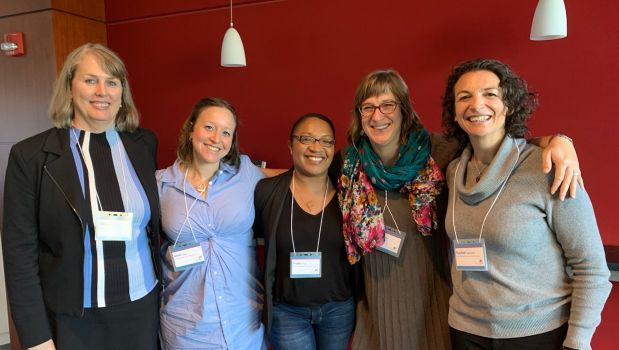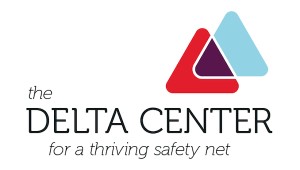Treating people first with Rapid Engagement

L-R: Cherryl Ramirez and Ariel Singer, with Delta Center colleagues Freda Ceaser, Katie Coleman, and Rachel Solotaroff (photo: Clancey Bateman)
How a Delta Center grantee is partnering with consumers to transform behavioral health services in Oregon
By Cherryl Ramirez, MPH, MPA, executive director of the Association of Oregon Community Mental Health Programs, and Ariel Singer, MPH, Rapid Engagement project lead and freelance health care strategist
The Delta Center for a Thriving Safety Net brings together state primary care and behavioral health associations to create a care system that is more equitable and better meets the needs of individuals and families. Since the Delta Center’s founding in 2018, the Center for Accelerating Care Transformation has supported Delta Center grantees in Oregon and several other states by providing technical assistance and hands-on coaching. In this blog, we hear from 2 of our key collaborators in Oregon, Cherryl Ramirez and Ariel Singer, about how they’re partnering with consumers to change the landscape of the state’s behavioral health services by designing and testing a new “treat first” approach called Rapid Engagement.
Rapid Engagement is a system transformation project in Oregon that aims to make it easier, faster, and more user-friendly for people in need to get behavioral health services right away.
In partnership with the Oregon Health Authority (OHA), the Association of Oregon Community Mental Health Programs is facilitating a multi-stakeholder planning and pilot process to design and test Rapid Engagement in Oregon, with a grant from the Delta Center for a Thriving Safety Net, funded by the Robert Wood Johnson Foundation.
The planning process has included representatives from community mental health programs, culturally-specific behavioral health programs, Coordinated Care Organizations (CCOs), Oregon’s version of Medicaid Accountable Care Organizations), the Oregon Council for Behavioral Health, and the Oregon Primary Care Association.
What was the impetus for Rapid Engagement?
OHA’s vision is to transform the statewide behavioral health system so that it is simple, meaningful, and responsive, with a major emphasis on health equity. The Rapid Engagement pilot is a trauma-informed and person-centered approach to behavioral health access and was inspired by the Treat First model in New Mexico. Rapid Engagement makes it quicker and easier for people to get started with services by creating more flexibility to focus early interactions on understanding and responding to consumer priorities, building trust, and establishing therapeutic relationships. The Rapid Engagement approach also eases the administrative burden on provider organizations, allowing them to focus on what they do best – helping their clients. It’s a win-win situation.
How are consumers involved in the co-design process?
We have been committed to partnering with people who have lived experience to co-design this new approach to behavior health services since the beginning of the pilot, with the goal of understanding what meaningful improvement looks like to the people served by the public behavioral health system.
In our efforts to design Rapid Engagement, we’re really trying to live by the principle of ‘nothing about me without me.’ The on-ramp for behavioral health services must become simpler, more meaningful, and more responsive from the consumer’s point of view – otherwise we haven’t achieved our goal. Understanding and incorporating the needs and perspectives of the people we serve is essential to effective system redesign. In the end, successfully engaging consumers in co-design is based on the same ideals as Rapid Engagement: we need to meet people where they are, understand their priorities, and respond to their wishes.
How did you engage consumers in co-design?
During this project, we have learned a lot about how best to engage people with lived experience in our co-design work. At first, we were aiming for a gold standard of having people with lived experience at the table on our steering committee across the life of the project. But we noticed that people would join the group and then stop engaging. One peer support specialist was very frank in telling us, “This is all administrator’s work. I don’t deal with this stuff, I don’t speak the language and I don’t feel like I belong at this table.” Even for the members of the peer workforce who were interested and ready to participate, their highest priority was serving clients and they were often pulled away from meetings to support people in need.
Eventually, we were successful in overcoming these challenges and getting input from geographically and culturally diverse people, through several strategies:
- Outreach to members of CCO consumer advisory councils, which include consumers who have already opted to be involved in system redesign and improvement efforts.
- Seek out members of the peer workforce in addition to consumers, who can speak to both their own experiences as well as their professional experiences in the behavioral health system.
- Build on existing and trusted relationships to tap into existing community groups.
- Acknowledge power differentials in group settings. To make the most of everyone’s time, we tried to engage consumers, peers, and organizations on the issues that were most relevant to them rather than presenting jargon and technical details to the whole group.
- Facilitate conversations with principles of trauma-informed practice and health literacy in mind, to ensure maximum accessibility for group members.
What’s next in Oregon?
We’re currently working with consumers, behavioral health providers, members of the peer workforce, Coordinated Care Organizations (CCOs), and OHA to design an operational model for Rapid Engagement. We have done a lot of planning in 2021, and in 2022, we are partnering with the University of Oregon to evaluate our Rapid Engagement pilot, which we are launching with 6 behavioral health programs and their Coordinated Care Organization (CCO) partners.
Using what we learn in the pilot, we hope to implement Rapid Engagement as the standard of care for all outpatient providers offering comprehensive behavioral health services in Oregon. Our goal is that consumers in any part of the state can expect to receive support, therapeutic services, and easy access to behavioral health care when they need and want it from their local agency, without having to answer a long list of questions just to start getting help.
Read more about Rapid Engagement and strategies we found successful in the Delta Center's overview and brief on lessons learned for member associations:
Thank you to the many consumers, peers, and leaders who shared their lived experience with us and to the partner organizations who helped make this possible:
- Willamette Health Council
- Central Oregon Health Council
- Eastern Oregon Coordinated Care Organization
- Deschutes County Behavioral Health
- Center for Human Development
- Puentes (culturally-specific program at Central City Concern providing mental health and substance use disorder services to the Latinx community)
- Flip the Script (culturally-specific program at Central City Concern that supports formerly incarcerated African Americans as they exit Oregon prisons)


